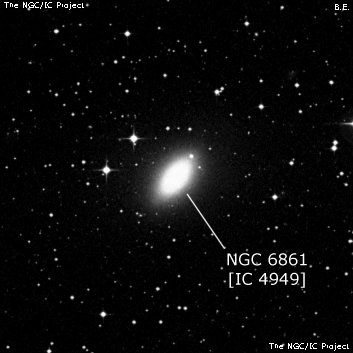
NGC 6861 is a lenticular galaxy located in the constellation Telescopium. It is the second-brightest object in the constellation. Unlike most lenticular galaxies, which tend to be mostly devoid of both gas and dust, NGC 6861 exhibits a thick obscuring ring of dust around the nucleus where star formation is occurring. The galaxy was discovered by Scottish astronomer James Dunlop, in 1826. NGC 6861 is interacting with NGC 6868, and it is predicted that they will eventually merge.
200/250mm - 8" (7/13/91 - Southern Baja): faint, small, elongated 2:1 WNW-ESE, bright core. Forms the western vertex of an isosceles right triangle with two stars following [mag 12 star 1.6' NE and mag 12.5 star 2.0' E]. NGC 6868 lies 25' E. Brightest along with NGC 6868 in a group including IC 4943 8.5' W (not seen).
400/500mm - 18" (7/7/05 - Magellan Observatory, Australia): at 228x, moderately bright, moderately large, elongated 5:3 NW-SE, 1.3'x0.8', fairly well concentrated with a small brighter core. Forms the SW vertex of a triangle with two equal mag 12 stars just 1.6' NE and 2' E. IC 4943 was viewed 8.5' W and probably NGC 6861D 14' NE but then clouds moved in and ended the observation.
18" (7/10/02 - Magellan Observatory, Australia): at 128x this galaxy appeared moderately bright, fairly small, elongated 2:1 NW-SE with a brighter core. Two nearby mag 12 stars, 1.6' NE and 2.0' E run parallel to the major axis of the galaxy. Brightest of four galaxies in field with IC 4943 8.5' W, NGC 6861B 14' SW and an anonymous galaxy 2.8' N of IC 4943. This is one of the brighter galaxies in the Telescopium Group = ACO S851.
600/800mm - 30" (10/18/17 - OzSky): at 429x; very bright, large, fairly large, beautiful lenticular, elongated 5:2 NW-SE, 1.8'x0.8' , sharply concentrated with a very bright oval core. There was a hint of a dust lane. Two 12th mag stars are 1.6' NE and 2' E of center. NGC 6861D, located 14' NE, appeared fairly bright, fairly large, very elongated 3:1 NNW-SSE, ~1.6'x0.5', strong concentration with a very bright elongated core and a stellar nucleus. A mag 10.4 star is 1.2' W. NGC 6861 is one of the two brightest members (along with NGC 6868) of the Telescopium Group = ACO S851.